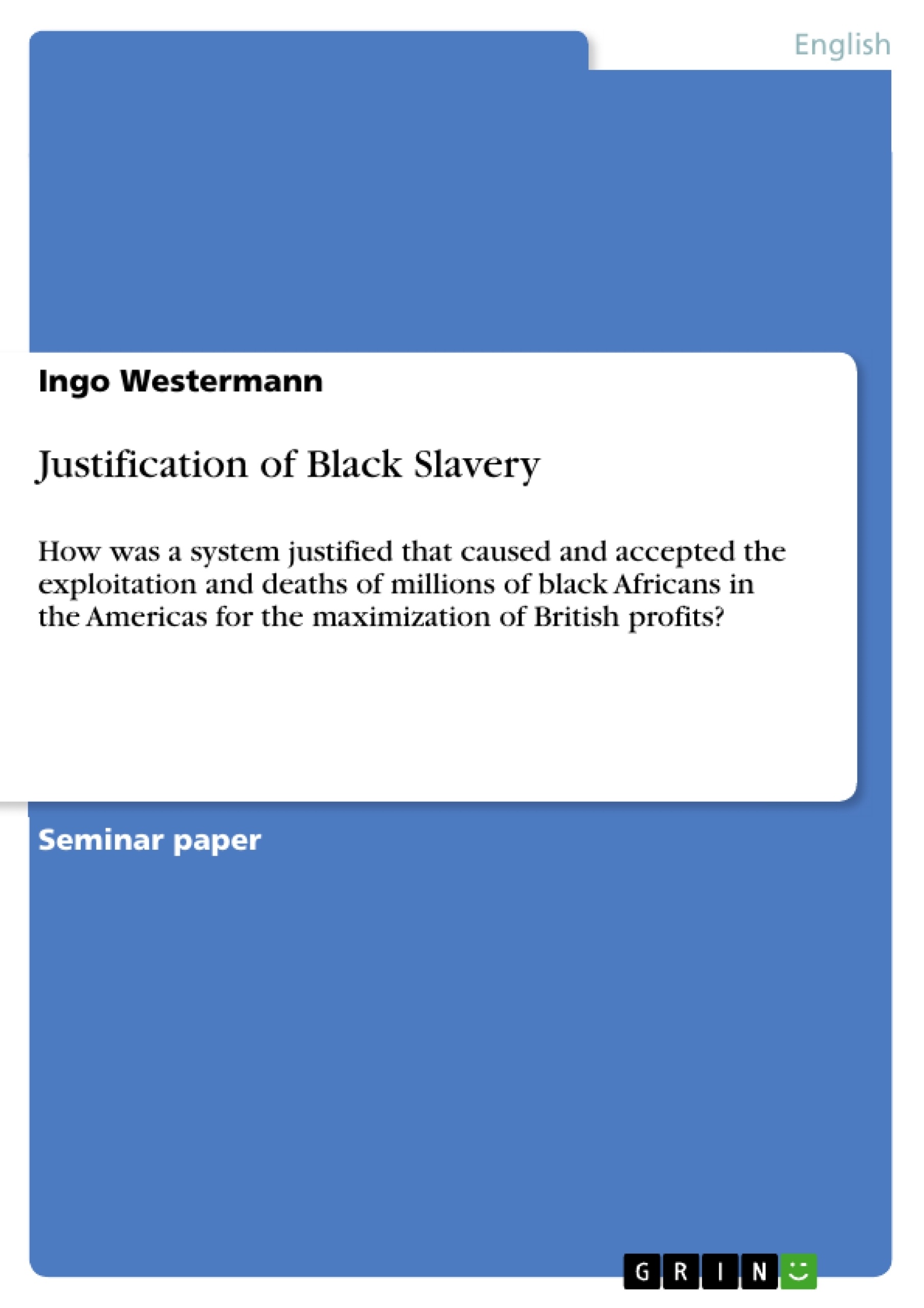In 1619 the first shipment of black Africans to British America arrived on the Atlantic coast of Virginia (cf. Morgan 2007: 21). This event marked the starting point for the development of a British large scale New World slave trading system that would eventually result in millions of Africans being deported from their home continent and shipped to the Americas.
Black Africans were taken by force, put on a gruesome voyage over the Atlantic, sold as if they were goods instead of human beings and then put to work on plantations for the rest of their lives, while in all of these stages their deaths and that of many other fellow captives was readily accepted.
From a today's point of view the described events and happenings appear utterly wrong, completely against any humane understanding, without any empathy for one's fellow being at all.
A question that arises from this discrepancy between the existence of a near unquestioned system of transatlantic slave trade and the incomprehensibility and condemnation of the very same thing less than two centuries later is that of a justification. How was a system justified that caused and accepted the exploitation and deaths of millions of black Africans in the Americas for the maximization of British profits? Within this question, another, closely related aspect is already implied: Why was slavery within this system exclusively limited to black Africans?
These are the two questions that I will focus on throughout the following pages.
The goal for this paper consists of two parts. I will attempt to provide a basis that will help to understand how this system could come into existence in the first place and be maintained for as long as it lasted. This will require pointing out shortcomings of earlier, economically focused models and the introduction of several other influential components. The concept of a network with a multitude of interdependent factors will be the central element for this step.
Secondly,I will take a closer look at religious motives, the related symbolism of the color black and the emergence of scientific racism, regarding their relevance and impact on the slave trade system and its maintenance. The final step of this paper will then consist of a last depiction of the network of reasons and explanations for the existence and sustenance of the British involvement in the transatlantic slave trade, visualizing the entanglement of multiple causalities
Inhaltsverzeichnis (Table of Contents)
- Introduction...
- Maximization of Profits vs. A Cultural Framework..
- A Network of Interdependent Elements…
- Cultural Bias, the Symbolism of the Color Black and Religious Influence.....
- The Emergence of Scientific Racism..
- Conclusion...
Zielsetzung und Themenschwerpunkte (Objectives and Key Themes)
This paper explores the justification of black slavery within the British Empire in the Atlantic world. It aims to understand how a system that exploited and caused the deaths of millions of Africans could have been accepted and maintained for so long. The paper analyzes the factors that contributed to the emergence and perpetuation of this system, going beyond purely economic explanations to consider cultural, religious, and scientific influences.
- The interplay of economic and cultural factors in shaping the transatlantic slave trade.
- The role of religious beliefs and the symbolism of the color black in justifying slavery.
- The emergence of scientific racism as a justification for the enslavement of Africans.
- The development of a network of interdependent elements that contributed to the maintenance of slavery.
- The historical context of slavery, considering its roots in ancient and medieval times.
Zusammenfassung der Kapitel (Chapter Summaries)
- Introduction: This chapter introduces the historical context of the transatlantic slave trade, highlighting the brutal reality of the system and the discrepancy between its existence and its condemnation in modern times. It presents the core question of the paper: how could such a system be justified? It also outlines the scope and methodology of the paper, emphasizing a multi-faceted approach that considers a range of influential factors.
- Maximization of Profits vs. A Cultural Framework: This chapter explores the argument that the transatlantic slave trade was driven by economic factors alone. It examines critiques of this narrow view and introduces the significance of cultural parameters in shaping the system. This chapter sets the stage for a more nuanced analysis that takes into account the complexity of the factors at play.
- A Network of Interdependent Elements…: This chapter delves into the interconnectedness of various factors that contributed to the perpetuation of slavery. It highlights the importance of understanding the system as a network of interdependent elements rather than as a result of a single cause. This chapter establishes the foundation for further analysis of specific influences.
Schlüsselwörter (Keywords)
The key themes and concepts explored in this paper include: transatlantic slave trade, British Empire, justification of slavery, cultural bias, religious influence, scientific racism, network of interdependent elements, historical context.
- Quote paper
- B.A. Ingo Westermann (Author), 2010, Justification of Black Slavery, Munich, GRIN Verlag, https://www.grin.com/document/150449



